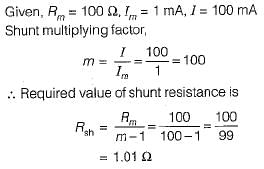Test: Electromechanical Indicating Instruments to Electrical & Electronics Measurements - Electrical Engineering (EE) MCQ
10 Questions MCQ Test GATE Electrical Engineering (EE) Mock Test Series 2026 - Test: Electromechanical Indicating Instruments to Electrical & Electronics Measurements
A moving coil instrument has the following data:
Number of turns = 100
Width of the coil = 20 mm
Depth of the coil = 30 mm
Flux density in the gap = 0.1 Wb/m2
If the control spring constant is 2 x 10-6 N-m/ degree, then the deflection of the pointer when the coil carries a current of 10 mA is
Number of turns = 100
Width of the coil = 20 mm
Depth of the coil = 30 mm
Flux density in the gap = 0.1 Wb/m2
If the control spring constant is 2 x 10-6 N-m/ degree, then the deflection of the pointer when the coil carries a current of 10 mA is
A PMMC uses a :
A moving iron movement uses
A 1 mA meter movement with an internal resistance of 100 Ω is to be converted into a 0-100 mA. The value of shunt resistant required is
Which of the following is not a desired characteristic of shunts used in PMMC instruments?
To select the range, a multirange ammeter uses a
A D’Arsonval movement is
What is the value of multiplier resistance on the 50 V range of a dc voltmeter that uses a 500 μA meter movement with an internal resistance of 1 kΩ?
Loading effect in a voltmeter can be avoided by
Assertion (A): Gravity control is not suited for indicating instruments in general and portable instruments in particular.
Reason (R): Gravity control is used in only vertically mounted instruments.
|
26 docs|257 tests
|
|
26 docs|257 tests
|



















